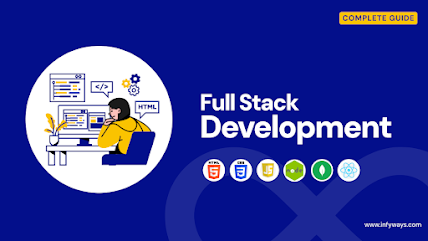Why Full Stack Development Should Be on Every Programmer’s Radar
The rising demand for technology-driven solutions compels web developers to gain knowledge and understanding of both front-end and back-end languages. The need for full-stack development professionals who can develop the client-side as well as the server-side of the application is in full swing. Companies across the globe are rigorously searching for professional developers who can build a complete web application right from scratch.
Partnering with a Full-Stack Development Company can be a strategic move for businesses aiming to build efficient and scalable digital products. These companies offer end-to-end development expertise, ensuring seamless integration, faster deployment, and a unified approach to software development.
According to the United States Bureau of Labor Statistics report, the demand for full-stack developers will exceed 8,53,000 by the year 2024. Companies consider full-stack app development professionals as invaluable assets for their business, due to the value that they add to the company.
What is Full-stack development?
- Front end: the appearance of the website or mobile app
- Back end: Database and app infrastructure that works under the hood
Full-stack Development Architecture
Full-stack development requires a solid grasp of both front-end and back-end programming languages. Mastering these languages and their roles empowers developers to excel in the industry. It involves working with various languages that efficiently structure data and manage API request-response cycles, enabling smooth data storage and retrieval.
Front-end Languages
- HTML: It is known as the backbone of the web. Developers use HTML to build all the websites on the internet.
- CSS: Cascading Style Sheet controls the way HTML looks and functions on a web page.
- JavaScript: Responsible for adding interactivity and making more complex animations work smoothly and flawlessly.
Back-end Languages
- PHP: Since PHP coding executes on the Server, it is known as a Server-side scripting language, specially designed for the web.
- C++: A widely used programming language that gives high-level control to programmers over system memory and resources. The developers often use it for complex programming.
- Java: An object-oriented, class-based programming language. Developers use it often to have as few application dependencies as possible.
- Python: A general-purpose, high-level, interpreted programming language that emphasizes code readability. Python development code is highly readable and allows app developers to work efficiently and integrate multiple systems seamlessly.
- JavaScript: A high-level, multi-paradigm, real-time compilation, interpreted programming language. Developers can use it for both front-end and back-end functionality.
Full-Stack Development: Frameworks & Libraries
Due to the popularity of frontend frameworks and libraries, the count continues to increase drastically. While developing a new app or a website, choosing the right frontend framework and library can ignite the process of full-stack app development.

Front-end Frameworks and Libraries
- AngularJS: Open-source, front-end framework mainly used to build Single Page Applications (SPAs). It allows extending HTML vocabulary for developing an interactive mobile app.
- Bootstrap: An open-source and free CSS framework focused on mobile-first and responsive mobile app development. A collaboration of JS components with JSS and HTML enables quick and more accessible web app development.
- jQuery: A small, fast, and feature-packed JavaScript library designed to simplify HTML document traversal, manipulation, event handling, Ajax, and animation tasks.
- SASS: A CSS extension language that is powerful, stable, feature-rich, mature, and professional grade. It extends the functionality of existing CSS on the website.
Back-end Frameworks and Libraries
- Express: An open-source, free web application framework for NodeJS, designed for building APIs and web apps
- Django: A free and open-source Python-based web framework that follows the model-template-view architectural pattern
- Laravel: An open-source and free PHP-based web framework that is based on Symfony and supports a model-view-controller architectural platform
- Rails: Rails, also known as Ruby on Rails, is a server-side web application platform that follows the model-view-controller architectural pattern.
- Spring: An application framework that can be used by any Java platform
- JS: An open-source, cross-platform JavaScript runtime environment that performs JavaScript code outside of a browser. App developers make use of NodeJS for building backend services such as APIs.
Full-Stack Development – Database
- Oracle: A multi-model database management system commonly used to run data warehousing, online transaction processing, and mixed database workloads
- MySQL: A relational database management system that is open source and is used with PHP to connect and manipulate databases
- MongoDB: A cross-platform document-oriented database management system popularly used in building modern apps
- PostgreSQL: A free and open-source relational database management system that focuses on technical standards compliance
- Cloud Firestore: Google Cloud Firestore is a NoSQL database built for automatic scaling, high performance, and ease of application development.

How does full-stack development help in increasing business?
Over the years, full-stack web development has evolved and extended hugely. A full-stack developer with a range of skills and experience can handle all the front-end and back-end related processes i rightfrom the concept to the final product. It helps to build highly intuitive apps that result in practical problem-solving.
Moreover, developers prefer these apps as they develop them comprehensively using state-of-the-art technology; this is why they are cost-effective. Furthermore, these apps are more practical for small businesses and startups. It helps to build a website or a mobile app that loads faster and is compatible across platforms.
Conclusion
Full-stack development stands as a cornerstone of modern software engineering, offering end-to-end capabilities that streamline the development process. With expertise across front-end, back-end, databases, and cloud technologies, full-stack developers play a crucial role in building scalable, responsive, and robust digital products.




Comments
Post a Comment